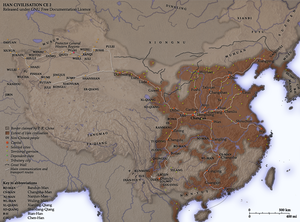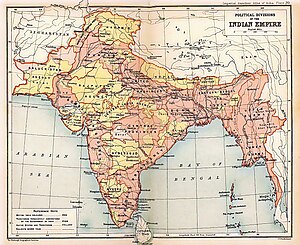History of Yunnan
This article needs additional citations for verification. (April 2008) |
This article describes the history of Yunnan (
Prehistory
Notable prehistoric finds include the Yuanmou Man, a Homo erectus fossil unearthed by railway engineers in the 1960s and determined to be the oldest known hominid fossil in China.
Neolithic
By the Neolithic period, human settlements existed in the area of
The Kingdom of Dian

The Dian culture was distributed around the

Han dynasty
In 109 BC,
In the Records of the Grand Historian, Zhang Qian (d. 113 BC) and Sima Qian (145-90 BC) make references to "Sendhuk", which may have been referring to an Indianised community taking the name from the Indus Valley (the Sindh province in modern Pakistan), originally known as "Sindhu" in Sanskrit. When Yunnan was annexed by the Han dynasty, Chinese authorities also reported a Sendhuk" (Indianised) community living in the area.[3]
In 109 AD, the Han court established Yunnan county, a part of Yizhou (益州) commandery. Because the county seat was south of Mount Yun (云山), the county was named "Yunnan" – literally "south of Yun".
Jin dynasty and the Northern and Southern dynasties period
Chinese dynasties of Jin, Liu Song, Southern Qi and Northern Zhou maintain their rules around the commandery in the Kunming area. Southwest Yunnan and the eastern rugged, mountainous areas were still enjoying relative independence, ruled by tribal kings and chieftains with little Chinese influence.
Nanzhao Kingdom
In 649 AD the chieftain of the
In 750, Nanzhao invaded the Tang dynasty. In retaliation, the Tang sent an army against Nanzhao in 751, but this army was soundly defeated at Xiaguan. In 754, another army was sent, this time from the north, but it too was defeated. Bolstered by these successes, Nanzhao expanded rapidly, first into Burma, then into the rest of Yunnan, down into northern Laos and Thailand, and finally, north into Sichuan. In 829, Chengdu was taken; it was a great prize, as it enabled Nanzhao to lay claim to the whole of Sichuan province, with its rich paddy fields.
The Tang dynasty retaliated and by 873, Nanzhao had been expelled from Sichuan, and retreated back to Yunnan. Taking Chengdu marked the high point of the Nanzhao kingdom, and it was a watershed: from then on, the Nanzhao Kingdom slowly declined. n 902, the Nanzhao dynasty was overthrown, and it was followed by three other dynasties in quick succession, until Duan Siping seized power in 937 to establish the Kingdom of Dali.
Dali Kingdom
Dali was a Buddhist
Yuan dynasty
The
Ming dynasty
The newly proclaimed
From the end of the 15th century, the
Qing dynasty


After the fall of the Ming in northern China, Yunnan became the last Southern Ming regime headed by Zhu Youlang. Supported by rebel loyalists, he persisted in resistance against the Qing conquest even after the Qing capture of Kunming in 1659. Zhu and his men then fled into Myanmar to seek refuge in Ava, but were treated as prisoners. Zhu's armed followers savaged Upper Myanmar in an attempt to rescue him. General Wu Sangui, then still loyal to the Qing, invaded Myanmar in 1662 with a sizable army, and demanded Zhu's surrender. Although he hesitated, King Pye finally decided to hand Zhu over to avoid hostility. Wu Sangui later turned against the Manchus but died in 1678. Yunnan finally fell to the Qing army in 1681.
Pingnan Sultanate
Waves of conflict between the Muslim Hui people in Yunnan and the Qing government escalated into an all out rebellion in 1856. The rebels in western Yunnan under the leadership of Du Wenxiu became the major military and political center of opposition to the Qing government. They turned their fury on the local mandarins and ended up challenging the central government in Beijing. The rebellion successfully captured the city of Dali, which became the base for the rebels' operations, and they declared themselves a separate political entity from China. The rebels identified their nation as Pingnan Guo (平南国; 'Pacified Southern Kingdom') and Du Wenxiu was styled Qa´id Jami al-Muslimin ('Leader of the Community of Muslims'), but is usually referred to in foreign sources as Sultan, and ruled 1856 – 26 December 1872. The sultanate reached the high-water mark of their power and glory in 1860.
The Sultanate's power declined after 1868. The Chinese Imperial Government had succeeded in reinvigorating itself. By 1871, it was directing a campaign for the annihilation of the obdurate Hui Muslims of Yunnan. Though largely forgotten, the bloody rebellion caused the deaths of up to a million people in Yunnan. Many adherents to the Yunnanese Muslim cause were persecuted by the imperial Manchus. Wholesale massacres of Yunnanese Muslims followed.
For a period of perhaps ten to fifteen years following the collapse of the Panthay Rebellion, the province's Hui minority was widely discriminated against by the victorious Qing, especially in the western frontier districts contiguous with Burma. During these years the refugee Hui settled across the frontier within Burma gradually established themselves in their traditional callings – as merchants, caravaneers, miners, restaurateurs and (for those who chose or were forced to live beyond the law) as smugglers and mercenaries and became known in Burma as the
Republican China

Following the collapse of the Qing dynasty in 1911, Yunnan came under the control of local warlords, who had more than the usual degree of autonomy due to Yunnan's remoteness. They financed their regime through opium harvesting and traffic.
In
People's Republic of China

The establishment of the PRC brought gradual but definite consolidation to China's southwestern borders, solidifying what were previously murky claims to various regions.
For example,
The PRC also saw a bitter Sino-Vietnamese War fought along Yunnan's south eastern border, which was properly demarcated only on 23 February 2009,[5] with renewed agreements taking effect as late as 14 July 2010.[6]
In the southern region of
References
- ISBN 978-0-521-12433-1.
- )
- ^ Tan Chung (1998). A Sino-Indian Perspective for India-China Understanding. Archived 6 June 2007 at the Wayback Machine
- ^ John Man Kublai Khan, p.80
- ^ "China-Vietnam border demarcation finished". Xinhua News Agency. 23 February 2009. Retrieved 19 August 2010.
- ^ "China-Vietnam land border demarcation agreements take effect Wednesday". Xinhua News Agency. 14 July 2010. Retrieved 19 August 2010.
- ISBN 974-7534-74-6.
Further reading
- Giersch, Charles Patterson (2006): Asian borderlands. The transformation of Qing China's Yunnan frontier. Cambridge, Massachusetts: Harvard Univ. Press.
- Yang, Bin (2009): Between winds and clouds. The making of Yunnan (second century BCE to twentieth century CE). New York, Chichester: Columbia University Press.

